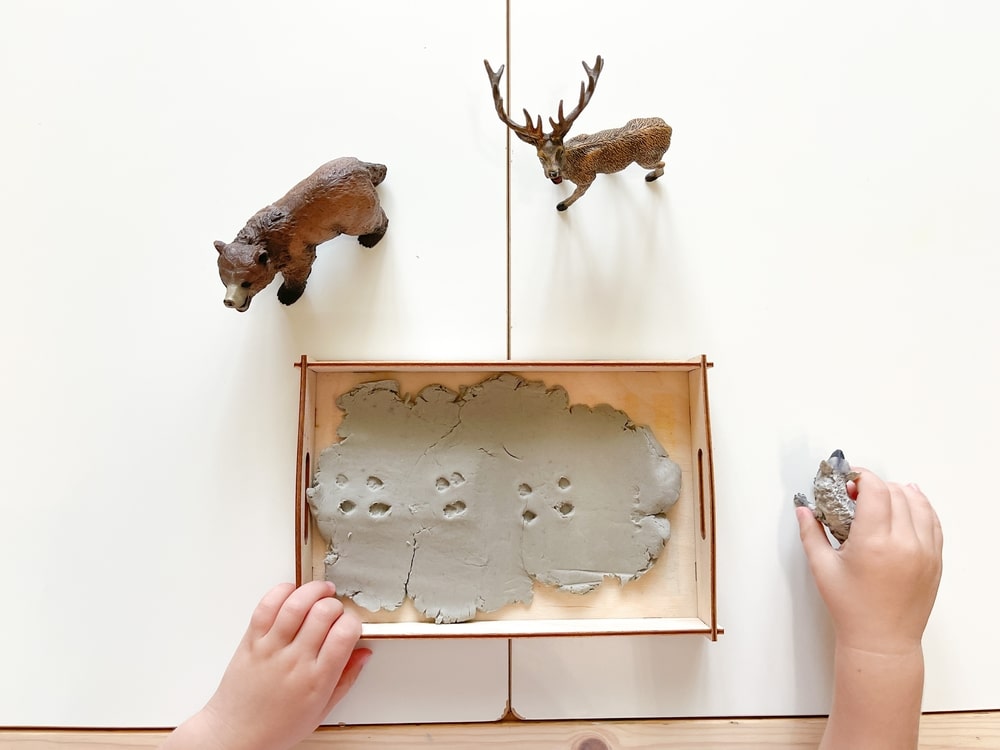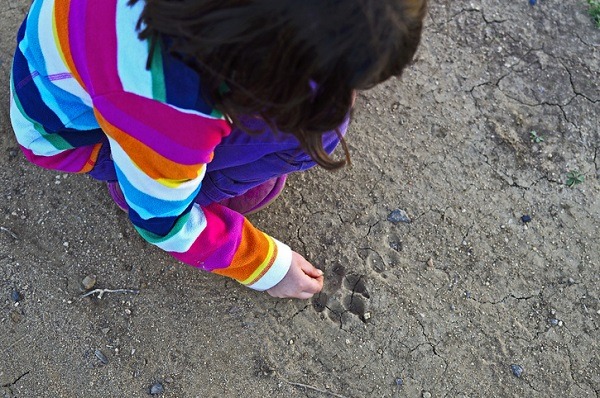© 2009 – 2021 Gwen Dewar, Ph.D., all rights reserved
These preschool and kindergarten science activities build on what most young children are already interested in — animals! And in addition to teaching lessons about biology, they also offer kids opportunities to practice analytical, spatial, and symbolic reasoning skills.

Where to begin: Free exploration with print-making
A child sees a footprint in the mud. Who left it? How can she know?
She might simply memorize what different types of footprints look like. But there’s a bigger, more interesting learning opportunity — one that involves spatial awareness and detective work. What happens when an object gets pressed into the mud? What shape, what physical impression, does it leave behind?
To get kids thinking about the processes that create animal tracks, we should give them the chance to experiment with print-making themselves.
So start out by providing kids with a print-making medium and supplies. It might be paint and paper. Or maybe some craft dough. Alternatively, you can use a surface of damp sand or dirt.
Then encourage kids to make prints with their hands and feet. You can give them plastic animal toys, too, and show them how to make impressions.
Advice about supplies
If you want to use paint and paper, I recommend that you test things out first. Finger paints can be too thick to leave behind clean impressions, and some poster paints may be too runny for younger kids to control. One solution is to make a stamp pad by soaking a sponge in nontoxic poster paint.
Salt dough or play dough is a good medium for making toy footprints. Ideally, you want a modeling compound that is soft enough that kids can roll it out themselves with a rolling pin. Note that some clays and commercial play doughs are too stiff for young children to do this easily.
Wet sand is fun, too. But it can be hard to see prints if the sun is directly overhead, so if you want to work outdoors you might try timing your activities for the morning or late afternoon.
And if you plan to work with dirt? Bring a little water and a spatula to prepare the surface, making it damp and smooth.
Questions to ask
As kids make tracks with animal toys, have them look at the toy feet and consider these questions. What do the feet look like? What shape are they? Do some creatures (like elephants and sauropod dinosaurs) have similar looking feet? Are their tracks similar, too?
After kids have had time to investigate on their own, you can try these science activities.
1. Observing and describing different kinds of feet
Have kids look at real feet, including non-human feet. The data might come from photographs or drawings, but don’t forget to take a look at some live models too. If you don’t have a non-human companion available at home to examine, you can observing creatures at the park, zoo, or pet shop. And don’t forget to encourage your child’s investigations by posing questions.
- How many toes are there?
- What does the bottom surface of the foot look like? Is it bumpy? Scaly? Smooth? Flat? Arched? What shapes do you see?
- When the creature walks, what parts of its feet touch the ground?
- Does the foot have nails? Hooves? Claws?
- If there are claws, do they touch the ground when the animal walks (as they do with dogs)? Or are the claws retracted (as they are in cats)?
2. Animal track testing
This is another activity that makes use of plastic animal toys. When your child isn’t looking, create a series of different tracks using the toy animals. Then present your child with the tracks — and the toys — and ask your child to match them up. Which toy made which track?
There are several ways to tackle this problem. One approach is to simply “eyeball” it: A child takes a look at the feet on a toy, and makes a prediction. What kind of tracks would these feet likely make? Then your child checks his answer by making his own set of tracks with this toy. Do they match?
Alternatively, your child might want to try placing the toy’s feet over the top of a given track (to see if it’s a good fit). If it looks promising, your child can then confirm the match by re-creating a similar set of tracks.
Or maybe your child will prefer to skip the preliminaries and simply make new impressions — comparing his tracks with yours to discover a match.
Whichever approach your child takes, get your child talking. When your child makes a prediction, or claims to have a match, ask her to explain. And encourage your child to use spatial language to describe her ideas.
3. Matching pictures
You can also present kids with pictures of different kinds of feet and ask kids to match the pictures with the right tracks.
To do this, make your own footprint cards. On each card, attach a picture of different type of animal footprint (e.g., a horse’s, a goose’s, an elephant’s, a dog’s). Then, on the back, attach pictures of the animal and animal foot associated with that footprint. Make a second set of cards identical with the first except that they are one-sided, showing the footprints only.
To play, arrange the double-sided cards on the table with the foot pictures face up. Then try to match with the single-sided footprint cards. Kids can check to see if their answers are correct by turning over the double-sided cards.
For free, printable pictures of North American animal tracks, check out bear-tracker.com. Author Kim Cabrera offers a free PDF guide to over 50 different kinds of tracks common in North America.
4. Looking for real tracks and other signs of animal life

Are you ready to try tracking animals in the wild? Perhaps you don’t live near wild places. But even if you’re stuck in the city, you may still find opportunities to track living creatures. Here are some examples:
- Cat foot prints on automobiles
- Scratch marks left on trees by cats and squirrels
- Prints left in the snow
- Snail and slug tracks
- Prints left in sand (e.g., at the playground)
- Droppings or scat left by birds, rodents, pets, etc.
- Spider webs
- Nut shells discarded by squirrels
- Evidence that leaves have been eaten by insects, snails, slugs, or other animals
And of course there are animal droppings, or scat, to consider. But make sure your child stays at a safe distance, and keep in mind that touch isn’t the only way to pick up germs from animal droppings. Some animal waste — like infected rodent droppings and urine deposits — can transmit disease when inhaled.
What can your child do when he or she finds something interesting? Measure and record it! When you go out tracking together, take along a ruler and a notebook. You might also keep a photo journal of your discoveries. Before taking a picture, put a coin alongside the feature of interest in order to give the viewer a sense of scale.
And bring a flashlight, too. Tracks can be hard to see in the direct sunlight. If you shine a flashlight on them, tilted at an angle, you can create shadows inside a track and better see it’s contours.
5. Experimenting with human footprints
This final science activity requires a degree of concentration to stay on task and think about the concepts. So it’s appropriate for older kids — including motivated kindergarteners. The project? Have kids create footprints while moving at different speeds — walking, running slow, and dashing quickly.
For best results, attempt this on a damp, sandy beach or expanse of damp dirt. Kids go barefoot, and see how their tracks vary.
What tracks are left behind when they walk? Or run? Do the shapes of the footprints look different? For example, if a child runs, is the heel strike more or less prominent? What about the ball of the foot? Is it possible to tell if someone was walking or running by looking at their tracks?
Resources: More information about animal tracking, and other preschool science activities
As noted above, bear-tracker.com offers free guides to animal tracks. There are also many helpful articles about tracking. It isn’t a website for young children, but it’s a great resource for adults.
You might also be interested in my article about the anthropology of tracking, as well as the following books:
- Selsam, Millicent E. 1995. Big tracks, little tracks: Following animal prints. New York: Harper Collins.
- George, Lindsay Barrett. 1999. In the snow: Who’s been here? New York: Harper Collins.
- George, Lindsay Barrett. 1998. Into the woods: Who’s been here? New York: Harper Collins.
These are picture books for young children, and they feature animals found in North American habitats.
For an additional resource — a visual reference that features creatures from all over the world — try the National Geographic guide, Animal Tracks and Signs: Track Over 400 Animals From Big Cats to Backyard Birds.
Looking for more science activities for young children? See this Parenting Science guide.
Content of “Animal tracks: Preschool and kindergarten science actitivities” last modified 2/2022
image of child making impressions on clay with toy animals by stasiya_gus / shutterstock
title image by JillianSuzanne / istock